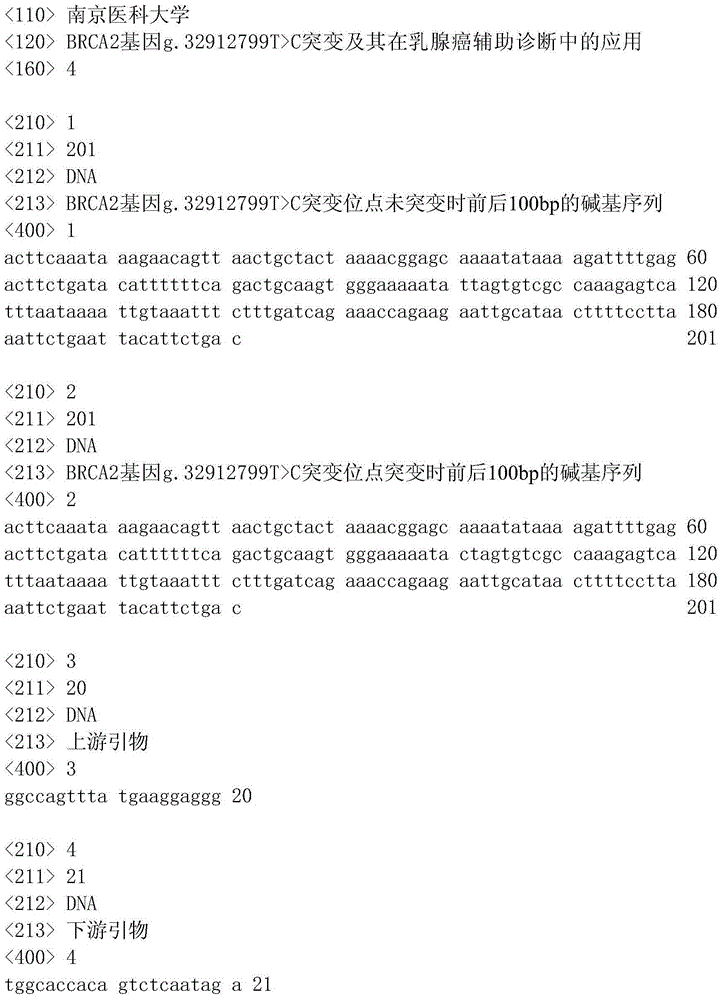BRCA2 gene g.32912799T>C mutation and application of mutation in auxiliary breast cancer diagnosis
A technology for auxiliary diagnosis and breast cancer, which is applied in the field of genetic engineering and oncology medicine, and can solve undiscovered problems
- Summary
- Abstract
- Description
- Claims
- Application Information
AI Technical Summary
Problems solved by technology
Method used
Image
Examples
Embodiment 1
[0064] The collection of embodiment 1 sample and the arrangement of sample data
[0065] From 2004 to 2013, the inventor collected a large number of blood samples from Chinese Han female breast cancer patients and normal population from the Nanjing Medical University Cancer Center and normal population in the community. The following standard samples Sanger sequencing scanning typed experimental samples:
[0066] 1. 70 cases of breast cancer patients with family history of breast cancer diagnosed by pathology;
[0067] 2. 3,000 cases of sporadic breast cancer patients without family history diagnosed by pathology;
[0068] 3. No family history of cancer, 3,000 healthy female controls matched with the age of the case;
[0069] 4. There are 7120 female samples in the whole population cohort from the community.
[0070] The demographic data and clinical data of these samples were collected systematically.
Embodiment 2
[0071] Example 2 Sequencing scanning of mutation sites in peripheral blood DNA
[0072] In the above 70 cases of breast cancer patients with family history and healthy controls, Sanger sequencing was used to obtain relevant results. The sequencing process followed the standard operation of Sanger sequencing, and artificially designed Sanger sequencing primers. The primer sequence was F: 5'-GGCCAGTTTATGAAGGAGGG-3 '(SEQ ID NO:3) and R:5'-TGGCACCACAGTCTCAATAGA-3'(SEQ ID NO:4), the primer sequences were synthesized by Nanjing GenScript (see Table 1 for details).
[0073] The specific steps are:
[0074] 1. Add hemolysis reagent (i.e. lysate, 40 parts) to the leukocytes stored in the 2ml cryopreservation tube. The volume of the solution was adjusted to 2000ml, the same below), and it was completely transferred after inverting and mixing.
[0075] 2. Removal of red blood cells: Fill the 5ml centrifuge tube to 4ml with hemolysis reagent, mix by inverting, centrifuge at 4000rpm for ...
Embodiment 3
[0086] Example 3 Sanger sequencing genotyping of a single mutation site
[0087] The above-mentioned Sanger sequencing scans found that the mutation sites related to the onset of breast cancer were found in 3,000 cases of sporadic Chinese Han female breast cancer patients with no family history and 3,000 Chinese Han females without family history of cancer, matched with the age of the cases The detection was carried out in healthy female controls, and the specific steps were as follows:
[0088] 1. Add the hemolysis reagent to the leukocytes stored in the 2ml cryopreservation tube, mix it upside down and transfer it completely.
[0089] 2. Removal of red blood cells: Fill the 5ml centrifuge tube to 4ml with hemolysis reagent, mix by inverting, centrifuge at 4000rpm for 10 minutes, and discard the supernatant. Add 4ml of hemolysis reagent to the precipitate, invert and wash again, centrifuge at 4000rpm for 10 minutes, and discard the supernatant.
[0090] 3. Extract DNA: Add 1m...
PUM
 Login to View More
Login to View More Abstract
Description
Claims
Application Information
 Login to View More
Login to View More - R&D
- Intellectual Property
- Life Sciences
- Materials
- Tech Scout
- Unparalleled Data Quality
- Higher Quality Content
- 60% Fewer Hallucinations
Browse by: Latest US Patents, China's latest patents, Technical Efficacy Thesaurus, Application Domain, Technology Topic, Popular Technical Reports.
© 2025 PatSnap. All rights reserved.Legal|Privacy policy|Modern Slavery Act Transparency Statement|Sitemap|About US| Contact US: help@patsnap.com


